Physics
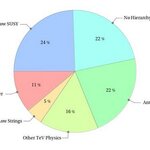
UPDATE: Just found out that Peter Woit anticipated me on this - see his blog entry.---
Just five years ago, on the eve of the start of the Large Hadron Collider, most particle physicists - experimentalists and theorists alike - would have been willing to bet their left testicle or ovary on the fact that new physics would very soon be discovered, most likely Supersymmetric particles (if a suitable payoff had been offered in exchange).
We all know that the picture has changed dramatically since then: the failure of ATLAS and CMS to observe any hint of new physics in their large datasets -…
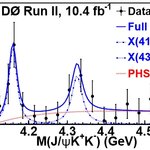
I have reported about the studies of resonances in the decays of the B+ meson by CDF, CMS, and LHCb a few times in the recent past. The situation, in a nutshell, was the following until yesterday: CDF found a new particle, the Y(4140), as a resonant (J/ψ φ) intermediate state produced when B+ mesons decay into a J/ψ, a φ, and a positive kaon; CDF also saw some evidence for a further excitation of the same two-body system; CMS confirmed the CDF claims, finding observation-level significance for both states; and LHCb did not confirm either of the two.
Furthermore Belle, a B-factory experiment…
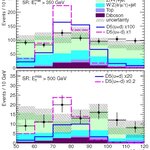
The ATLAS Collaboration published last week the results of a search for dark matter particles produced in association with a W or Z boson by the 8-TeV proton-proton collisions collected during the 2012 run of the Large Hadron Collider. The search uses techniques similar to ones I have described in recent articles here discussing results of the CMS experiments on different new physics signatures, and I thought it would be interesting to review it here.
ATLAS, like CMS, is a multi-purpose particle detector operating at the CERN Large Hadron Collider (LHC), a facility producing the highest-…

How to present in a simple way the spinorial space-time and the privileged space direction it generates? What is the fundamental difference between space-time spinors and the conventional description of space and time? What is the relevance for the analysis of WMAP and Planck data ?
Now that cosmologists are trying to reproduce the Planck anomalies using involved inflationary patterns, it seems relevant to emphasize that the privileged space direction is an immediate and natural consequence of the spinorial space-time, and that this approach is just a description of space and time such as…
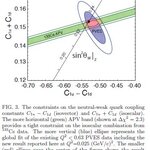
Researchers are reporting the first experimental determination of the weak charge of the proton, one of the four fundamental forces in our universe, along with gravity, electromagnetism and the strong force.
Although the weak force acts only on the sub-atomic level, we can see its effects in our everyday world. The weak force plays a key role in the nuclear reaction processes that take place in stars and is responsible for much of the natural radiation present in our universe.
The determinations were made by combining the new data with published data from other experiments.…

Three weeks ago I gave a plenary talk at the 2nd International Conference on New Frontiers in Physics, which was held in Kolymbari, in the greek island of Crete. The talk focused on some of the most interesting new results by the CMS Collaboration, but being just 30' long it only contained a summary of these. The purpose of the talk was primarily that of advertising the many talks on specific physics topics -Top, Higgs, Exotica, QCD- which were given by some of my colleagues in the parallel sessions; however I was able to show and discuss some nice new measurements myself.
Here I cannot…
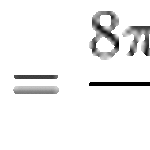
Moore's Law, originating in 1965 [1], is an observation of transistor density on a single CPU core increasing exponentially with time. Futurists such as Ray Kurzweil [2] extend this to the claim that CPU-core computation rate (operations per second) will also increase exponentially with time, allowing for a technological explosion of super-intelligent machines in soon-to-come decades.
I, to be clear from the outset, do not agree with Kurzweil et al. for multiple reasons. First of all, he has not justified the assumption that computation speed is the only major barrier to such a…

Moore's Law, originating in 1965 [1], is an observation of transistor density on a single CPU core increasing exponentially with time. Futurists such as Ray Kurzweil [2] extend this to the claim that CPU-core computation rate (operations per second) will also increase exponentially with time, allowing for a technological explosion of super-intelligent machines in soon-to-come decades.
I, to be clear from the outset, do not agree with Kurzweil et al. for multiple reasons. First of all, he has not justified the assumption that computation speed is the only major barrier to such a…

Moore's Law, originating in 1965 [1], is an observation of transistor density on a single CPU core increasing exponentially with time. Futurists such as Ray Kurzweil [2] extend this to the claim that CPU-core computation rate (operations per second) will also increase exponentially with time, allowing for a technological explosion of super-intelligent machines in soon-to-come decades.
I, to be clear from the outset, do not agree with Kurzweil et al. for multiple reasons. First of all, he has not justified the assumption that computation speed is the only major barrier to such a…
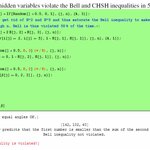
Very good news for the Quantum Randi Challenge, the most engaging bit of science outreach that already helped tripping up a notorious crackpot, and which now starts to gain momentum toward its main aim, which is helping a wide audience to understand the essence of quantum mechanics while being immunized against quantum–mysticism, which is sadly promoted by established scientists as badly as by snake-oil sellers.
Finding the collaboration by educators and artists that the Quantum Randi Challenge needs is now easier, as most of the didactic core has passed the scientific community’s peer review…